How Followers Influence Leaders: A Research Proposal for NZ Orgs
VerifiedAdded on 2021/07/05
|12
|3222
|409
Report
AI Summary
Nazmul Hoque's research proposal, submitted for Advanced Applied Management, investigates the influence of followers on leaders within two Nelson, NZ non-profit organizations. The study aims to understand how followers shape leadership decisions, focusing on the roles, behaviors, and influence tactics employed. The proposal outlines a literature review covering followership theories, including social construction and implicit theories, and examines factors that influence leaders and the impact of leader-follower relationships on organizational success. The proposed methodology involves qualitative data analysis, primarily semi-structured interviews with leaders and followers, supported by secondary research from academic literature. Ethical considerations such as confidentiality, potential biases, and participant rights are addressed, along with research management and budget details. The research intends to explore follower influence in practical settings, contributing to the understanding of effective leadership and management dynamics within non-profit contexts.
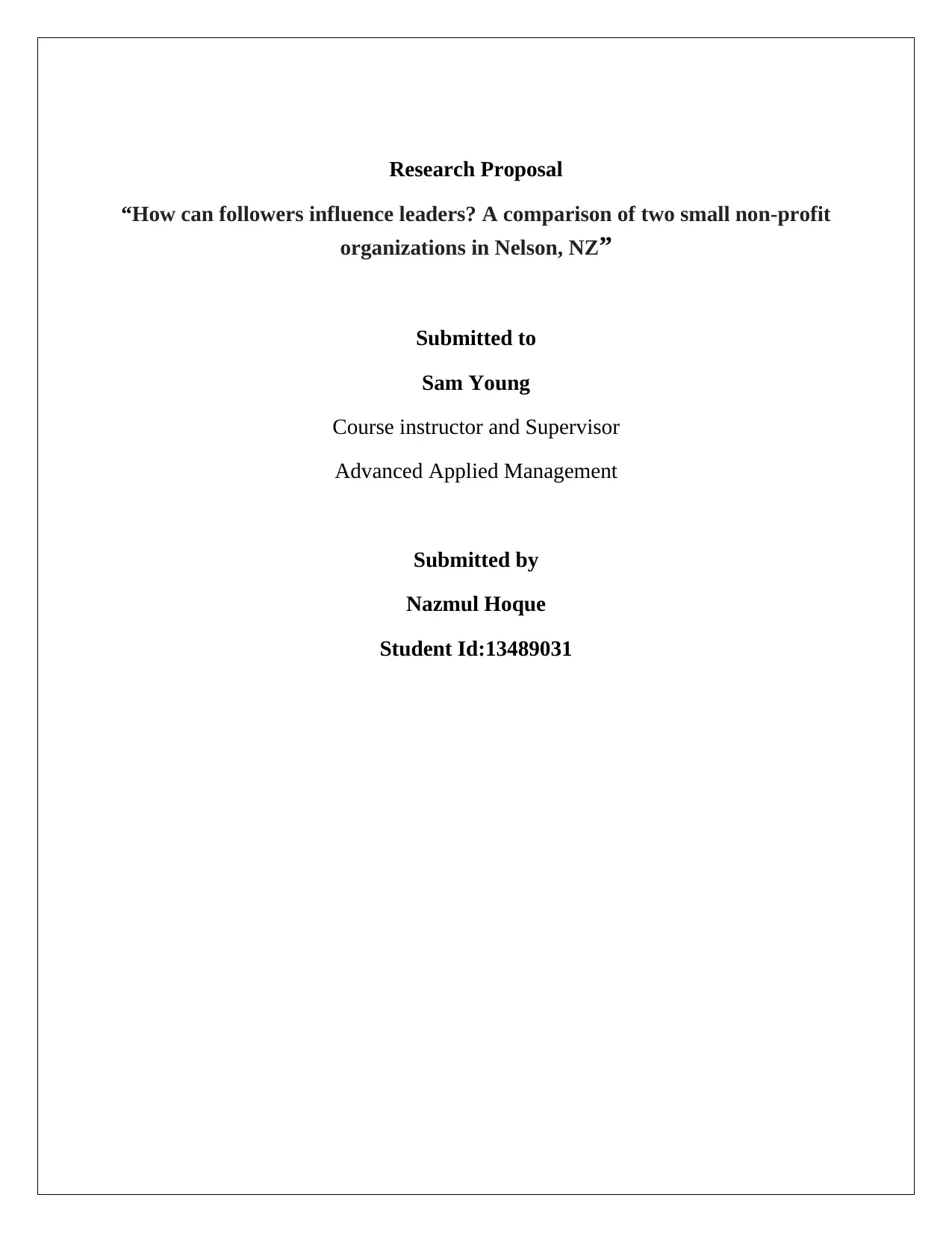
Research Proposal
“How can followers influence leaders? A comparison of two small non-profit
organizations in Nelson, NZ”
Submitted to
Sam Young
Course instructor and Supervisor
Advanced Applied Management
Submitted by
Nazmul Hoque
Student Id:13489031
“How can followers influence leaders? A comparison of two small non-profit
organizations in Nelson, NZ”
Submitted to
Sam Young
Course instructor and Supervisor
Advanced Applied Management
Submitted by
Nazmul Hoque
Student Id:13489031
Paraphrase This Document
Need a fresh take? Get an instant paraphrase of this document with our AI Paraphraser
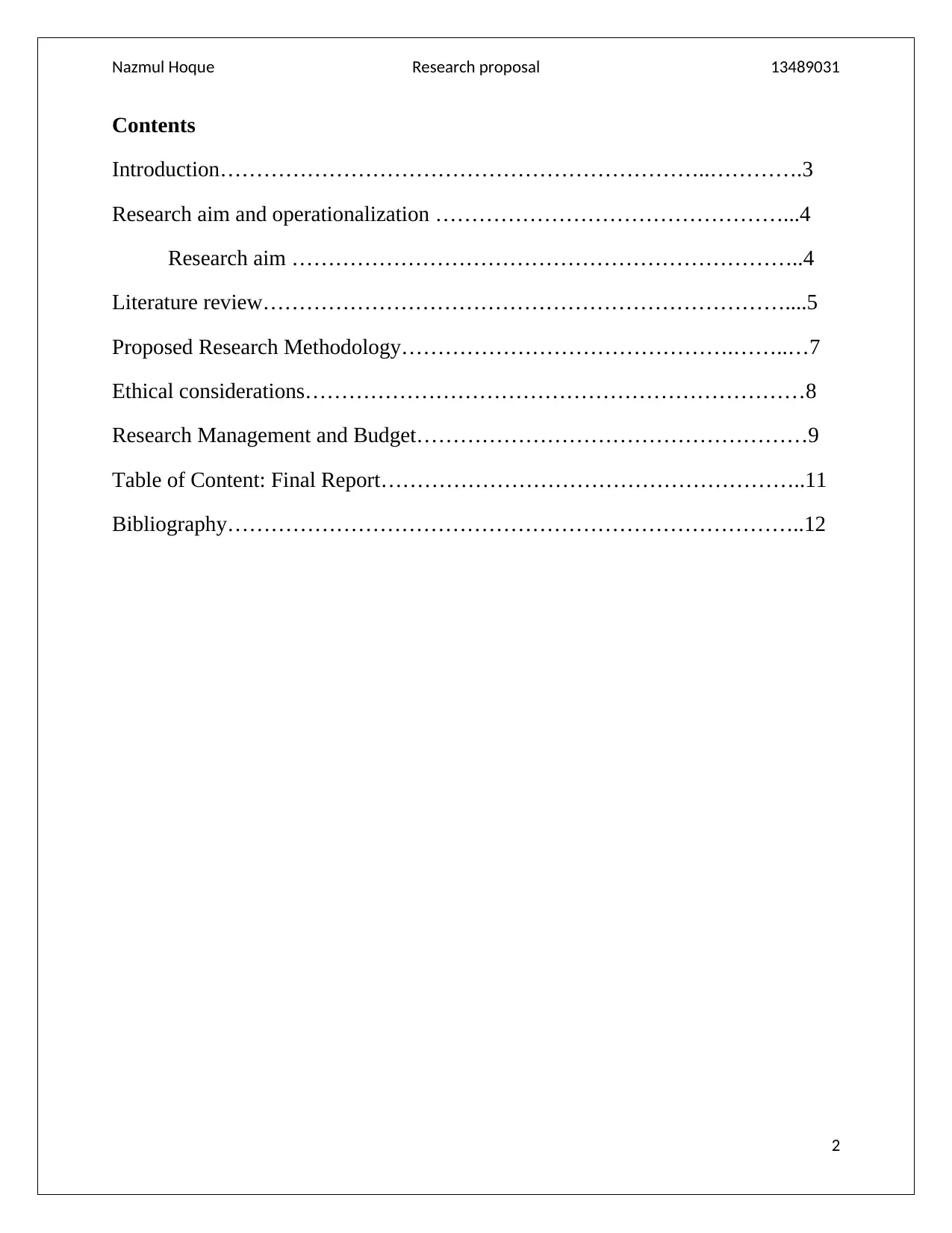
Nazmul Hoque Research proposal 13489031
Contents
Introduction…………………………………………………………..………….3
Research aim and operationalization …………………………………………...4
Research aim ……………………………………………………………..4
Literature review………………………………………………………………....5
Proposed Research Methodology……………………………………….……..…7
Ethical considerations……………………………………………………………8
Research Management and Budget………………………………………………9
Table of Content: Final Report…………………………………………………..11
Bibliography……………………………………………………………………..12
2
Contents
Introduction…………………………………………………………..………….3
Research aim and operationalization …………………………………………...4
Research aim ……………………………………………………………..4
Literature review………………………………………………………………....5
Proposed Research Methodology……………………………………….……..…7
Ethical considerations……………………………………………………………8
Research Management and Budget………………………………………………9
Table of Content: Final Report…………………………………………………..11
Bibliography……………………………………………………………………..12
2

Nazmul Hoque Research proposal 13489031
Introduction:
Sport is my passion. From my childhood, I was involved in different games like athletics, football etc. I
love to watch football a lot specially Spanish league. My favourite team is Real Madrid and Cristiano
Ronaldo is my favourite player. He was the best player of the team but he was not captain or I meant to
say he was not leader. But he had an outstanding career with Real Madrid and had huge achievement. He
had a strong role in team and always took part in decision making. This is a real life example. Like
Cristiano Ronaldo, lot of follower are everyday influence their leader in decision making.
Most the research are concentrated on leadership but a very few study found about followers role. I am
going to research on followership role. Some studies also started to investigate the role of follower
(Shamir, 2007; p. 9). What the role a follower has been performing in the perception of leadership
(Avolio, Walumbwa & Weber, 2009; Collinson, 2006)
The study of followership is very important for the better understanding of leadership (Shamir, 2007). My
research topic is that “How can followers influence leaders”? To get the real life experience, I have
chosen non -profit organization as a field of study and will try to bring the answer of my research
question “How much influence do followers have over their leaders in two Nelson non-profit
organizations, how and when is that influence used?”
3
Introduction:
Sport is my passion. From my childhood, I was involved in different games like athletics, football etc. I
love to watch football a lot specially Spanish league. My favourite team is Real Madrid and Cristiano
Ronaldo is my favourite player. He was the best player of the team but he was not captain or I meant to
say he was not leader. But he had an outstanding career with Real Madrid and had huge achievement. He
had a strong role in team and always took part in decision making. This is a real life example. Like
Cristiano Ronaldo, lot of follower are everyday influence their leader in decision making.
Most the research are concentrated on leadership but a very few study found about followers role. I am
going to research on followership role. Some studies also started to investigate the role of follower
(Shamir, 2007; p. 9). What the role a follower has been performing in the perception of leadership
(Avolio, Walumbwa & Weber, 2009; Collinson, 2006)
The study of followership is very important for the better understanding of leadership (Shamir, 2007). My
research topic is that “How can followers influence leaders”? To get the real life experience, I have
chosen non -profit organization as a field of study and will try to bring the answer of my research
question “How much influence do followers have over their leaders in two Nelson non-profit
organizations, how and when is that influence used?”
3
⊘ This is a preview!⊘
Do you want full access?
Subscribe today to unlock all pages.

Trusted by 1+ million students worldwide

Nazmul Hoque Research proposal 13489031
Research Aim and operationalization:
To find a management functions in research, I have chosen leadership in my field of study. So far,
different scholars are involved to find out how leaders influence followers? As inspiration from my
introduction, I want to research the reverse study that how can followers influence leaders? To get the
answer of this, my research will be focused on How much influence do followers have over their leaders
in two Nelson non-profit organizations, how and when is that influence used?”
Research aims:
The following aim will be used to get the answer of research questions.
i. The role of follower:
The key word of the research is follower which can be explain through journal article,
academic book, scholarly article etc. To understand the actual role of a follower, researcher
will take interview from both leader and follower of two non-profit organization. After
getting the idea from interviewee, researcher will implement academic profound knowledge
to explain the role of follower.
ii. Factors that influence leader:
Researcher will try to find the factors that influence leader, how and when it will be used. Researcher
will take interview to get the best answer. Beside these, journal article, scholarly article etc. will be
used to get supportive data.
iii. Leaders-followers relationship impact on non-profit organization
Success of organization depends on its stakeholder. To know the relationship impact of leader-
followers impact, researcher will take interview from four persons. As non-profit organizations, role
and objective are different, researcher will take interview from two different kinds of non- profit
organization personnel, so that it may give a clear idea about relationship impact. Beside this,
researcher will explain nature of non-profit organization in light of Journal article, Academic books,
Scholarly article etc.
4
Research Aim and operationalization:
To find a management functions in research, I have chosen leadership in my field of study. So far,
different scholars are involved to find out how leaders influence followers? As inspiration from my
introduction, I want to research the reverse study that how can followers influence leaders? To get the
answer of this, my research will be focused on How much influence do followers have over their leaders
in two Nelson non-profit organizations, how and when is that influence used?”
Research aims:
The following aim will be used to get the answer of research questions.
i. The role of follower:
The key word of the research is follower which can be explain through journal article,
academic book, scholarly article etc. To understand the actual role of a follower, researcher
will take interview from both leader and follower of two non-profit organization. After
getting the idea from interviewee, researcher will implement academic profound knowledge
to explain the role of follower.
ii. Factors that influence leader:
Researcher will try to find the factors that influence leader, how and when it will be used. Researcher
will take interview to get the best answer. Beside these, journal article, scholarly article etc. will be
used to get supportive data.
iii. Leaders-followers relationship impact on non-profit organization
Success of organization depends on its stakeholder. To know the relationship impact of leader-
followers impact, researcher will take interview from four persons. As non-profit organizations, role
and objective are different, researcher will take interview from two different kinds of non- profit
organization personnel, so that it may give a clear idea about relationship impact. Beside this,
researcher will explain nature of non-profit organization in light of Journal article, Academic books,
Scholarly article etc.
4
Paraphrase This Document
Need a fresh take? Get an instant paraphrase of this document with our AI Paraphraser
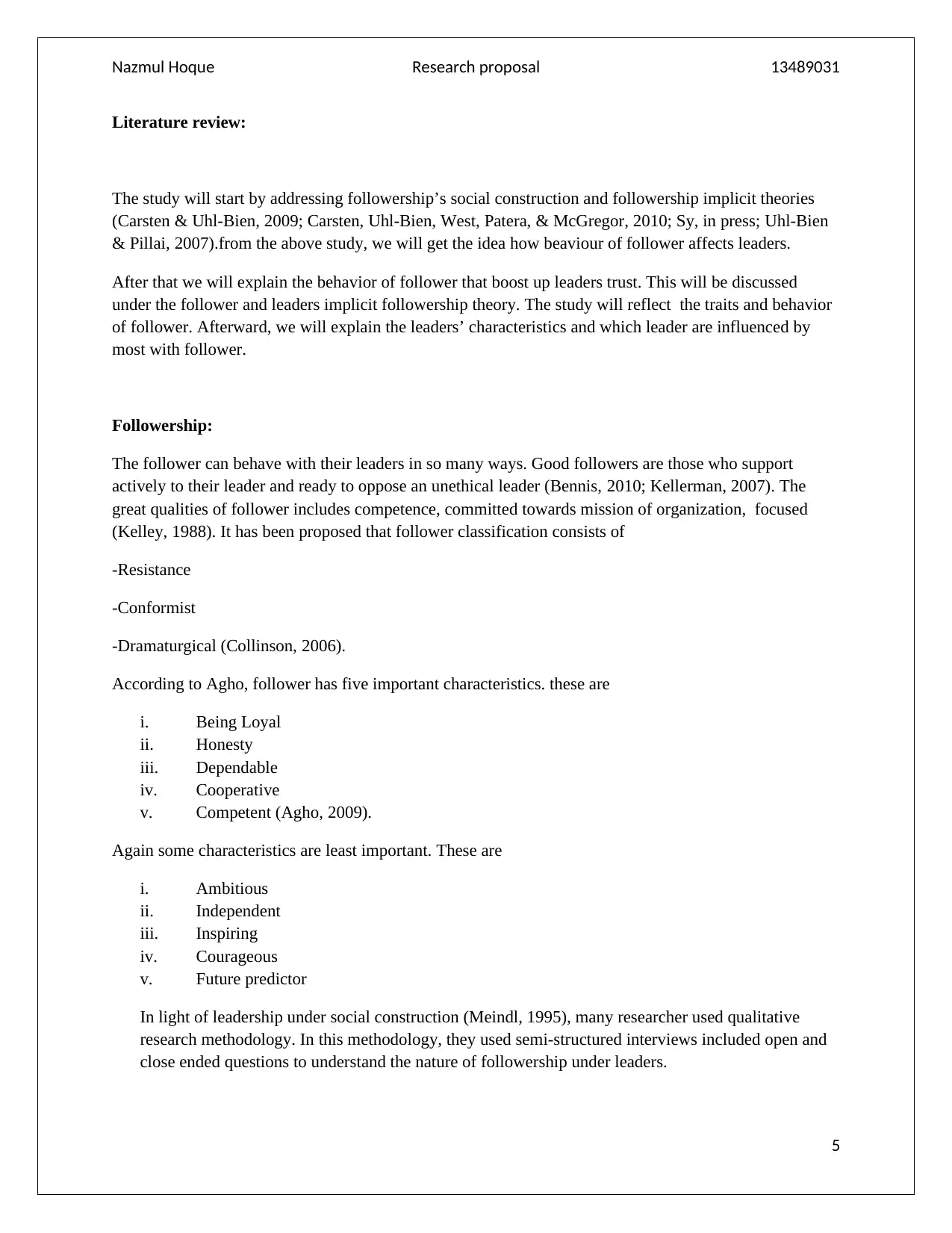
Nazmul Hoque Research proposal 13489031
Literature review:
The study will start by addressing followership’s social construction and followership implicit theories
(Carsten & Uhl‐Bien, 2009; Carsten, Uhl‐Bien, West, Patera, & McGregor, 2010; Sy, in press; Uhl‐Bien
& Pillai, 2007).from the above study, we will get the idea how beaviour of follower affects leaders.
After that we will explain the behavior of follower that boost up leaders trust. This will be discussed
under the follower and leaders implicit followership theory. The study will reflect the traits and behavior
of follower. Afterward, we will explain the leaders’ characteristics and which leader are influenced by
most with follower.
Followership:
The follower can behave with their leaders in so many ways. Good followers are those who support
actively to their leader and ready to oppose an unethical leader (Bennis, 2010; Kellerman, 2007). The
great qualities of follower includes competence, committed towards mission of organization, focused
(Kelley, 1988). It has been proposed that follower classification consists of
-Resistance
-Conformist
-Dramaturgical (Collinson, 2006).
According to Agho, follower has five important characteristics. these are
i. Being Loyal
ii. Honesty
iii. Dependable
iv. Cooperative
v. Competent (Agho, 2009).
Again some characteristics are least important. These are
i. Ambitious
ii. Independent
iii. Inspiring
iv. Courageous
v. Future predictor
In light of leadership under social construction (Meindl, 1995), many researcher used qualitative
research methodology. In this methodology, they used semi-structured interviews included open and
close ended questions to understand the nature of followership under leaders.
5
Literature review:
The study will start by addressing followership’s social construction and followership implicit theories
(Carsten & Uhl‐Bien, 2009; Carsten, Uhl‐Bien, West, Patera, & McGregor, 2010; Sy, in press; Uhl‐Bien
& Pillai, 2007).from the above study, we will get the idea how beaviour of follower affects leaders.
After that we will explain the behavior of follower that boost up leaders trust. This will be discussed
under the follower and leaders implicit followership theory. The study will reflect the traits and behavior
of follower. Afterward, we will explain the leaders’ characteristics and which leader are influenced by
most with follower.
Followership:
The follower can behave with their leaders in so many ways. Good followers are those who support
actively to their leader and ready to oppose an unethical leader (Bennis, 2010; Kellerman, 2007). The
great qualities of follower includes competence, committed towards mission of organization, focused
(Kelley, 1988). It has been proposed that follower classification consists of
-Resistance
-Conformist
-Dramaturgical (Collinson, 2006).
According to Agho, follower has five important characteristics. these are
i. Being Loyal
ii. Honesty
iii. Dependable
iv. Cooperative
v. Competent (Agho, 2009).
Again some characteristics are least important. These are
i. Ambitious
ii. Independent
iii. Inspiring
iv. Courageous
v. Future predictor
In light of leadership under social construction (Meindl, 1995), many researcher used qualitative
research methodology. In this methodology, they used semi-structured interviews included open and
close ended questions to understand the nature of followership under leaders.
5
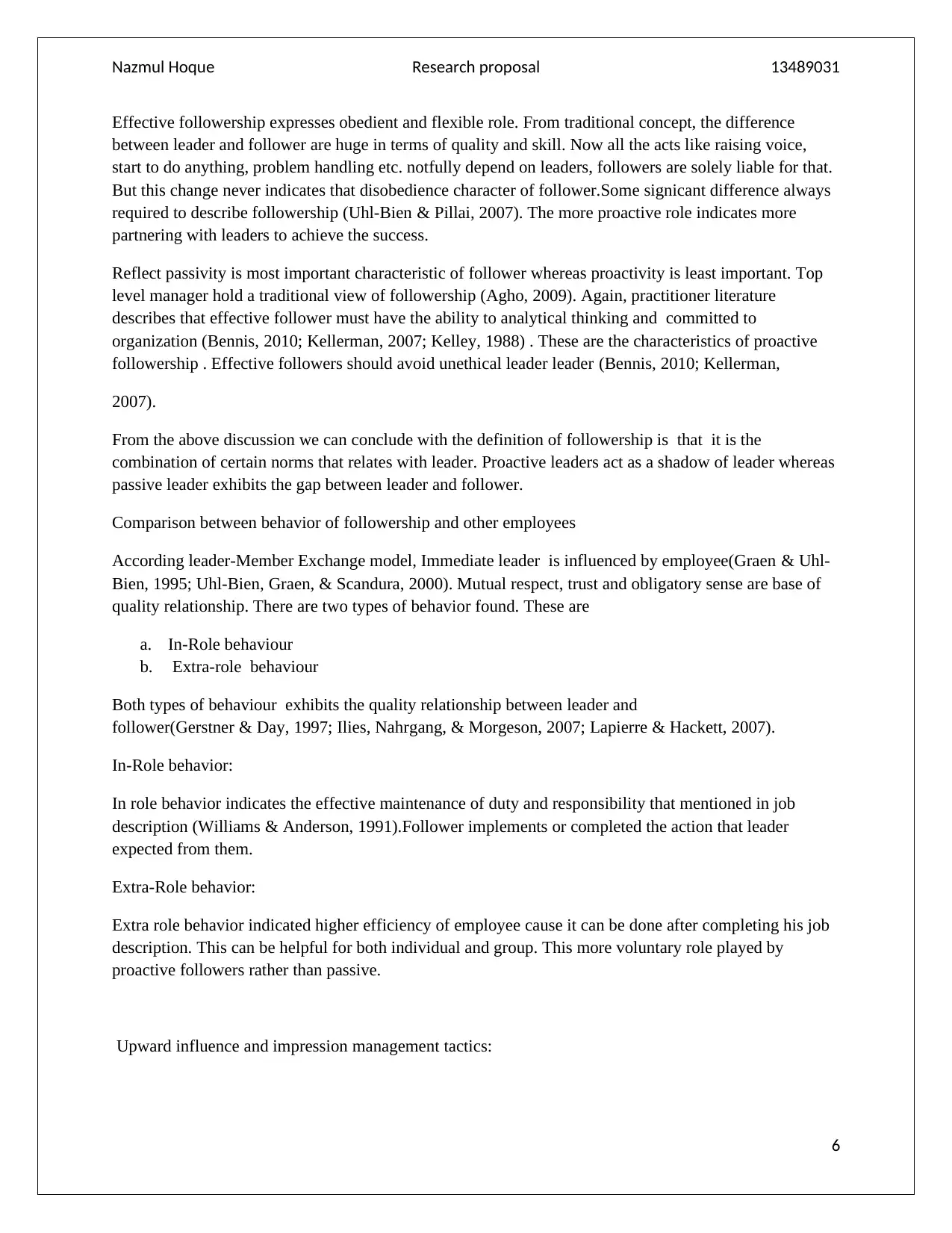
Nazmul Hoque Research proposal 13489031
Effective followership expresses obedient and flexible role. From traditional concept, the difference
between leader and follower are huge in terms of quality and skill. Now all the acts like raising voice,
start to do anything, problem handling etc. notfully depend on leaders, followers are solely liable for that.
But this change never indicates that disobedience character of follower.Some signicant difference always
required to describe followership (Uhl‐Bien & Pillai, 2007). The more proactive role indicates more
partnering with leaders to achieve the success.
Reflect passivity is most important characteristic of follower whereas proactivity is least important. Top
level manager hold a traditional view of followership (Agho, 2009). Again, practitioner literature
describes that effective follower must have the ability to analytical thinking and committed to
organization (Bennis, 2010; Kellerman, 2007; Kelley, 1988) . These are the characteristics of proactive
followership . Effective followers should avoid unethical leader leader (Bennis, 2010; Kellerman,
2007).
From the above discussion we can conclude with the definition of followership is that it is the
combination of certain norms that relates with leader. Proactive leaders act as a shadow of leader whereas
passive leader exhibits the gap between leader and follower.
Comparison between behavior of followership and other employees
According leader-Member Exchange model, Immediate leader is influenced by employee(Graen & Uhl‐
Bien, 1995; Uhl‐Bien, Graen, & Scandura, 2000). Mutual respect, trust and obligatory sense are base of
quality relationship. There are two types of behavior found. These are
a. In-Role behaviour
b. Extra-role behaviour
Both types of behaviour exhibits the quality relationship between leader and
follower(Gerstner & Day, 1997; Ilies, Nahrgang, & Morgeson, 2007; Lapierre & Hackett, 2007).
In-Role behavior:
In role behavior indicates the effective maintenance of duty and responsibility that mentioned in job
description (Williams & Anderson, 1991).Follower implements or completed the action that leader
expected from them.
Extra-Role behavior:
Extra role behavior indicated higher efficiency of employee cause it can be done after completing his job
description. This can be helpful for both individual and group. This more voluntary role played by
proactive followers rather than passive.
Upward influence and impression management tactics:
6
Effective followership expresses obedient and flexible role. From traditional concept, the difference
between leader and follower are huge in terms of quality and skill. Now all the acts like raising voice,
start to do anything, problem handling etc. notfully depend on leaders, followers are solely liable for that.
But this change never indicates that disobedience character of follower.Some signicant difference always
required to describe followership (Uhl‐Bien & Pillai, 2007). The more proactive role indicates more
partnering with leaders to achieve the success.
Reflect passivity is most important characteristic of follower whereas proactivity is least important. Top
level manager hold a traditional view of followership (Agho, 2009). Again, practitioner literature
describes that effective follower must have the ability to analytical thinking and committed to
organization (Bennis, 2010; Kellerman, 2007; Kelley, 1988) . These are the characteristics of proactive
followership . Effective followers should avoid unethical leader leader (Bennis, 2010; Kellerman,
2007).
From the above discussion we can conclude with the definition of followership is that it is the
combination of certain norms that relates with leader. Proactive leaders act as a shadow of leader whereas
passive leader exhibits the gap between leader and follower.
Comparison between behavior of followership and other employees
According leader-Member Exchange model, Immediate leader is influenced by employee(Graen & Uhl‐
Bien, 1995; Uhl‐Bien, Graen, & Scandura, 2000). Mutual respect, trust and obligatory sense are base of
quality relationship. There are two types of behavior found. These are
a. In-Role behaviour
b. Extra-role behaviour
Both types of behaviour exhibits the quality relationship between leader and
follower(Gerstner & Day, 1997; Ilies, Nahrgang, & Morgeson, 2007; Lapierre & Hackett, 2007).
In-Role behavior:
In role behavior indicates the effective maintenance of duty and responsibility that mentioned in job
description (Williams & Anderson, 1991).Follower implements or completed the action that leader
expected from them.
Extra-Role behavior:
Extra role behavior indicated higher efficiency of employee cause it can be done after completing his job
description. This can be helpful for both individual and group. This more voluntary role played by
proactive followers rather than passive.
Upward influence and impression management tactics:
6
⊘ This is a preview!⊘
Do you want full access?
Subscribe today to unlock all pages.

Trusted by 1+ million students worldwide
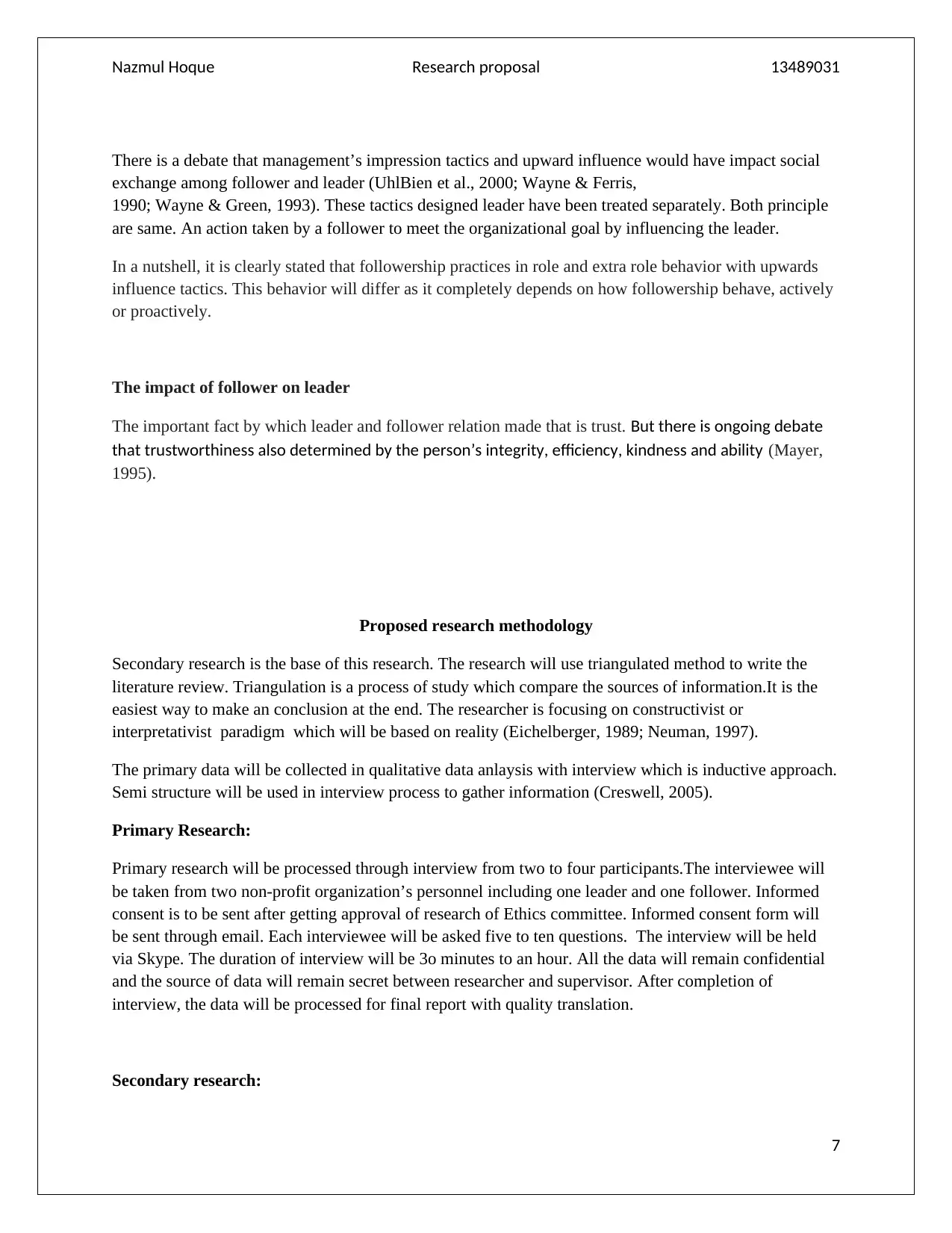
Nazmul Hoque Research proposal 13489031
There is a debate that management’s impression tactics and upward influence would have impact social
exchange among follower and leader (UhlBien et al., 2000; Wayne & Ferris,
1990; Wayne & Green, 1993). These tactics designed leader have been treated separately. Both principle
are same. An action taken by a follower to meet the organizational goal by influencing the leader.
In a nutshell, it is clearly stated that followership practices in role and extra role behavior with upwards
influence tactics. This behavior will differ as it completely depends on how followership behave, actively
or proactively.
The impact of follower on leader
The important fact by which leader and follower relation made that is trust. But there is ongoing debate
that trustworthiness also determined by the person’s integrity, efficiency, kindness and ability (Mayer,
1995).
Proposed research methodology
Secondary research is the base of this research. The research will use triangulated method to write the
literature review. Triangulation is a process of study which compare the sources of information.It is the
easiest way to make an conclusion at the end. The researcher is focusing on constructivist or
interpretativist paradigm which will be based on reality (Eichelberger, 1989; Neuman, 1997).
The primary data will be collected in qualitative data anlaysis with interview which is inductive approach.
Semi structure will be used in interview process to gather information (Creswell, 2005).
Primary Research:
Primary research will be processed through interview from two to four participants.The interviewee will
be taken from two non-profit organization’s personnel including one leader and one follower. Informed
consent is to be sent after getting approval of research of Ethics committee. Informed consent form will
be sent through email. Each interviewee will be asked five to ten questions. The interview will be held
via Skype. The duration of interview will be 3o minutes to an hour. All the data will remain confidential
and the source of data will remain secret between researcher and supervisor. After completion of
interview, the data will be processed for final report with quality translation.
Secondary research:
7
There is a debate that management’s impression tactics and upward influence would have impact social
exchange among follower and leader (UhlBien et al., 2000; Wayne & Ferris,
1990; Wayne & Green, 1993). These tactics designed leader have been treated separately. Both principle
are same. An action taken by a follower to meet the organizational goal by influencing the leader.
In a nutshell, it is clearly stated that followership practices in role and extra role behavior with upwards
influence tactics. This behavior will differ as it completely depends on how followership behave, actively
or proactively.
The impact of follower on leader
The important fact by which leader and follower relation made that is trust. But there is ongoing debate
that trustworthiness also determined by the person’s integrity, efficiency, kindness and ability (Mayer,
1995).
Proposed research methodology
Secondary research is the base of this research. The research will use triangulated method to write the
literature review. Triangulation is a process of study which compare the sources of information.It is the
easiest way to make an conclusion at the end. The researcher is focusing on constructivist or
interpretativist paradigm which will be based on reality (Eichelberger, 1989; Neuman, 1997).
The primary data will be collected in qualitative data anlaysis with interview which is inductive approach.
Semi structure will be used in interview process to gather information (Creswell, 2005).
Primary Research:
Primary research will be processed through interview from two to four participants.The interviewee will
be taken from two non-profit organization’s personnel including one leader and one follower. Informed
consent is to be sent after getting approval of research of Ethics committee. Informed consent form will
be sent through email. Each interviewee will be asked five to ten questions. The interview will be held
via Skype. The duration of interview will be 3o minutes to an hour. All the data will remain confidential
and the source of data will remain secret between researcher and supervisor. After completion of
interview, the data will be processed for final report with quality translation.
Secondary research:
7
Paraphrase This Document
Need a fresh take? Get an instant paraphrase of this document with our AI Paraphraser

Nazmul Hoque Research proposal 13489031
Secondary research is fully based on academic literature. The secondary research includes books,
journals, scholarly article, Dissertation papers, web information etc. these are filtered through triangulated
literature review. NMIT pro-quest will help to get quality data. Beside these, supervisor has given a long
reference list for the study, it will so also help to reach quality data. Some resources will be taken from
NMIT library. Google scholarly article will help to get relevant data as well.
Ethical considerations:
Confidentiality/ Anonymity
Data will be kept securely to researcher’s laptop. The laptop is password protected and google drive will
be used to ensure data backup.
Anonymity won’t be possible in process of interview as both researcher and supervisor acknowledged
about the identity of interviewee. To cover the fact, researcher will introduce interviewee as a leader 1
without using name and organization in full report.
Vulnerable Participants:
Interviewee personnel are professional, mature and privileged in society. None of them are vulnerable
participants.
Chances of Potential Biases:
Primary data will be collected through interview. There is change for bias as because of all the
information is based on perception of interviewee. Researcher will meet with supervisor and take
guideline how to avoid potential bias.
Harm to Participants
The whole interview process is flexible. There is no chance for physical and mental harm to participants.
Data also be kept securely.
Deception:
Free from deception.
Informed Consent:
Informed consent will be obtained via a signed form. It will be signed before interview. Both parties will
keep the record. Participant has the right to withdraw his/her part from research before the submission of
final report. Participant name, organization name will not be used anywhere of the report. Data will be
8
Secondary research is fully based on academic literature. The secondary research includes books,
journals, scholarly article, Dissertation papers, web information etc. these are filtered through triangulated
literature review. NMIT pro-quest will help to get quality data. Beside these, supervisor has given a long
reference list for the study, it will so also help to reach quality data. Some resources will be taken from
NMIT library. Google scholarly article will help to get relevant data as well.
Ethical considerations:
Confidentiality/ Anonymity
Data will be kept securely to researcher’s laptop. The laptop is password protected and google drive will
be used to ensure data backup.
Anonymity won’t be possible in process of interview as both researcher and supervisor acknowledged
about the identity of interviewee. To cover the fact, researcher will introduce interviewee as a leader 1
without using name and organization in full report.
Vulnerable Participants:
Interviewee personnel are professional, mature and privileged in society. None of them are vulnerable
participants.
Chances of Potential Biases:
Primary data will be collected through interview. There is change for bias as because of all the
information is based on perception of interviewee. Researcher will meet with supervisor and take
guideline how to avoid potential bias.
Harm to Participants
The whole interview process is flexible. There is no chance for physical and mental harm to participants.
Data also be kept securely.
Deception:
Free from deception.
Informed Consent:
Informed consent will be obtained via a signed form. It will be signed before interview. Both parties will
keep the record. Participant has the right to withdraw his/her part from research before the submission of
final report. Participant name, organization name will not be used anywhere of the report. Data will be
8
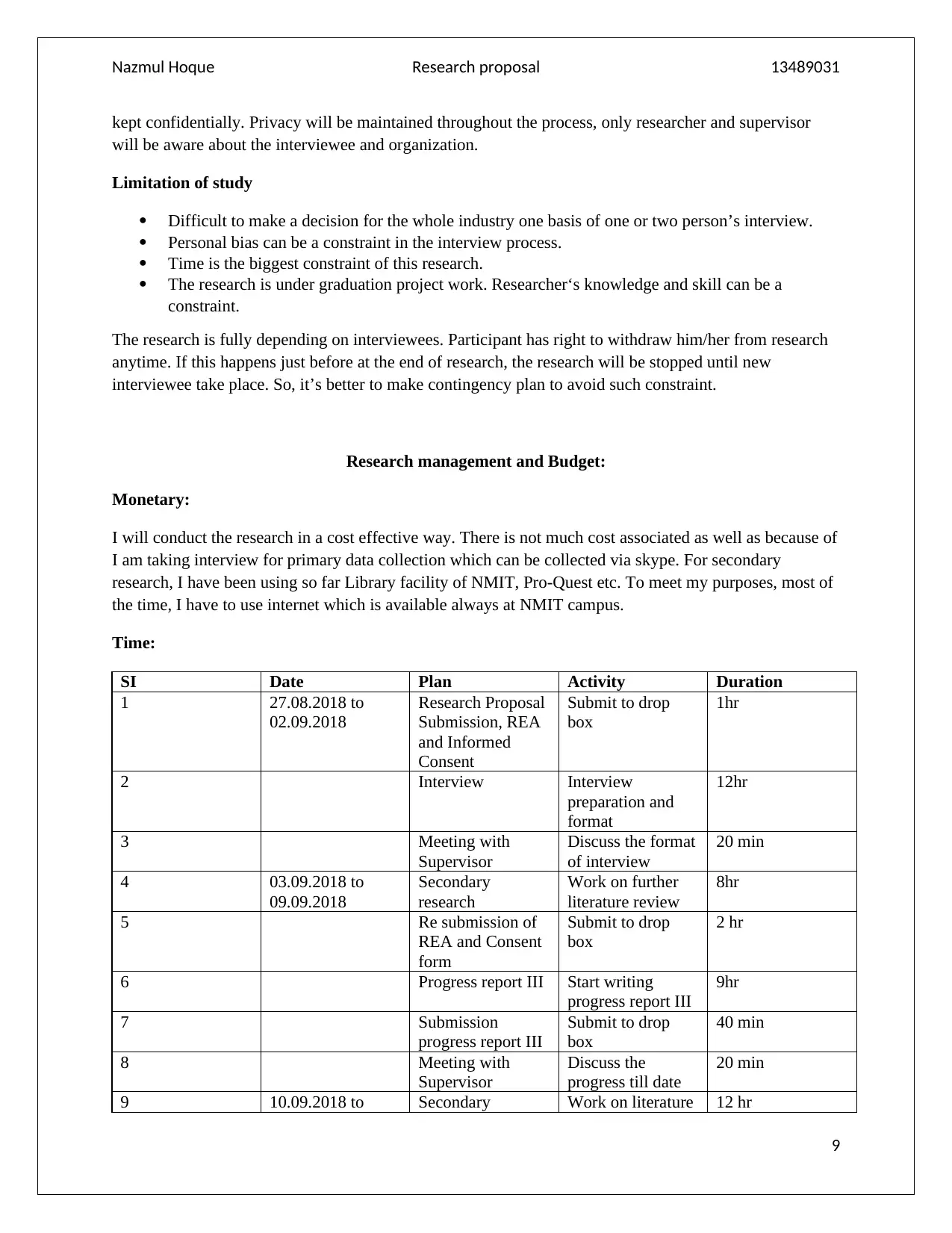
Nazmul Hoque Research proposal 13489031
kept confidentially. Privacy will be maintained throughout the process, only researcher and supervisor
will be aware about the interviewee and organization.
Limitation of study
Difficult to make a decision for the whole industry one basis of one or two person’s interview.
Personal bias can be a constraint in the interview process.
Time is the biggest constraint of this research.
The research is under graduation project work. Researcher‘s knowledge and skill can be a
constraint.
The research is fully depending on interviewees. Participant has right to withdraw him/her from research
anytime. If this happens just before at the end of research, the research will be stopped until new
interviewee take place. So, it’s better to make contingency plan to avoid such constraint.
Research management and Budget:
Monetary:
I will conduct the research in a cost effective way. There is not much cost associated as well as because of
I am taking interview for primary data collection which can be collected via skype. For secondary
research, I have been using so far Library facility of NMIT, Pro-Quest etc. To meet my purposes, most of
the time, I have to use internet which is available always at NMIT campus.
Time:
SI Date Plan Activity Duration
1 27.08.2018 to
02.09.2018
Research Proposal
Submission, REA
and Informed
Consent
Submit to drop
box
1hr
2 Interview Interview
preparation and
format
12hr
3 Meeting with
Supervisor
Discuss the format
of interview
20 min
4 03.09.2018 to
09.09.2018
Secondary
research
Work on further
literature review
8hr
5 Re submission of
REA and Consent
form
Submit to drop
box
2 hr
6 Progress report III Start writing
progress report III
9hr
7 Submission
progress report III
Submit to drop
box
40 min
8 Meeting with
Supervisor
Discuss the
progress till date
20 min
9 10.09.2018 to Secondary Work on literature 12 hr
9
kept confidentially. Privacy will be maintained throughout the process, only researcher and supervisor
will be aware about the interviewee and organization.
Limitation of study
Difficult to make a decision for the whole industry one basis of one or two person’s interview.
Personal bias can be a constraint in the interview process.
Time is the biggest constraint of this research.
The research is under graduation project work. Researcher‘s knowledge and skill can be a
constraint.
The research is fully depending on interviewees. Participant has right to withdraw him/her from research
anytime. If this happens just before at the end of research, the research will be stopped until new
interviewee take place. So, it’s better to make contingency plan to avoid such constraint.
Research management and Budget:
Monetary:
I will conduct the research in a cost effective way. There is not much cost associated as well as because of
I am taking interview for primary data collection which can be collected via skype. For secondary
research, I have been using so far Library facility of NMIT, Pro-Quest etc. To meet my purposes, most of
the time, I have to use internet which is available always at NMIT campus.
Time:
SI Date Plan Activity Duration
1 27.08.2018 to
02.09.2018
Research Proposal
Submission, REA
and Informed
Consent
Submit to drop
box
1hr
2 Interview Interview
preparation and
format
12hr
3 Meeting with
Supervisor
Discuss the format
of interview
20 min
4 03.09.2018 to
09.09.2018
Secondary
research
Work on further
literature review
8hr
5 Re submission of
REA and Consent
form
Submit to drop
box
2 hr
6 Progress report III Start writing
progress report III
9hr
7 Submission
progress report III
Submit to drop
box
40 min
8 Meeting with
Supervisor
Discuss the
progress till date
20 min
9 10.09.2018 to Secondary Work on literature 12 hr
9
⊘ This is a preview!⊘
Do you want full access?
Subscribe today to unlock all pages.

Trusted by 1+ million students worldwide
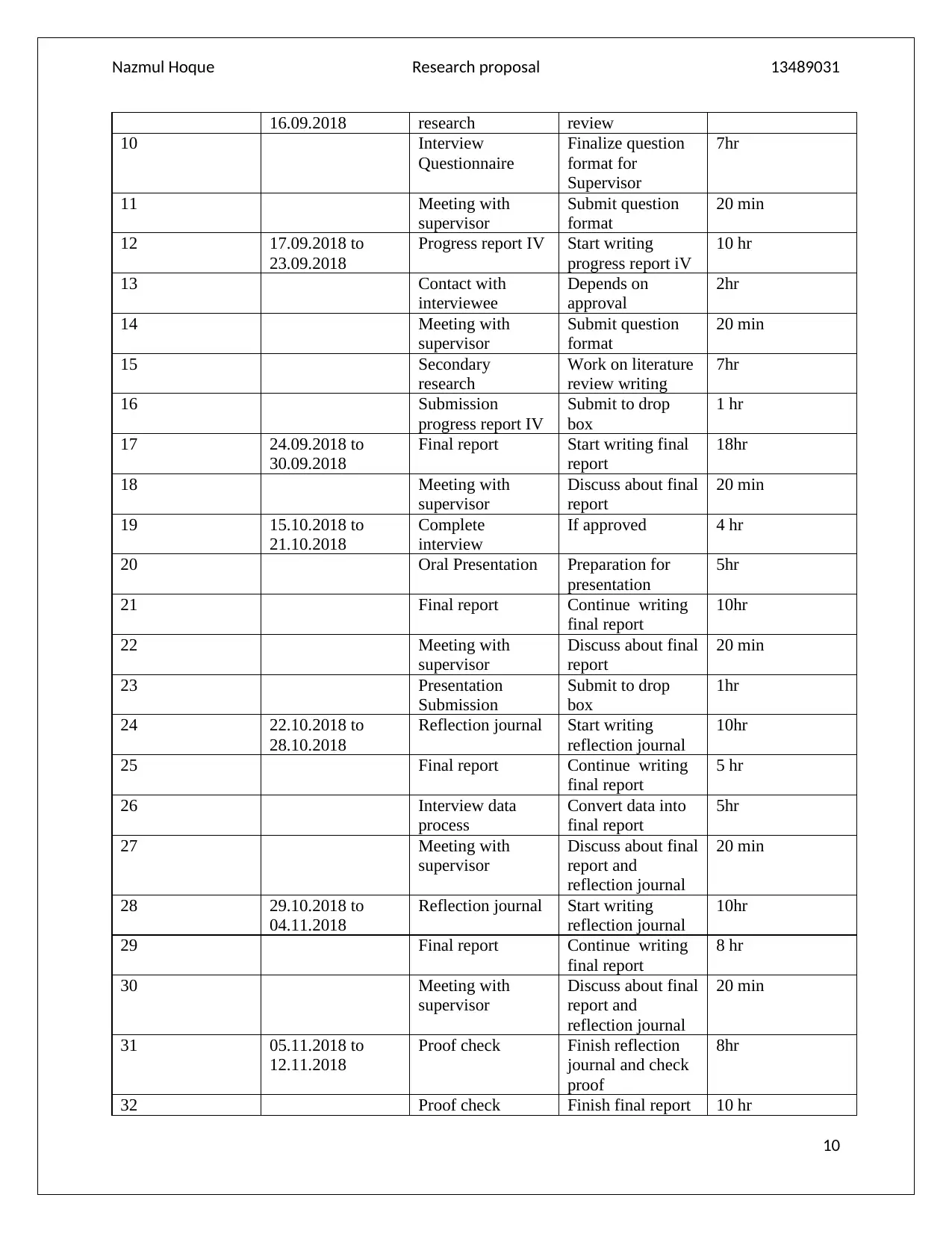
Nazmul Hoque Research proposal 13489031
16.09.2018 research review
10 Interview
Questionnaire
Finalize question
format for
Supervisor
7hr
11 Meeting with
supervisor
Submit question
format
20 min
12 17.09.2018 to
23.09.2018
Progress report IV Start writing
progress report iV
10 hr
13 Contact with
interviewee
Depends on
approval
2hr
14 Meeting with
supervisor
Submit question
format
20 min
15 Secondary
research
Work on literature
review writing
7hr
16 Submission
progress report IV
Submit to drop
box
1 hr
17 24.09.2018 to
30.09.2018
Final report Start writing final
report
18hr
18 Meeting with
supervisor
Discuss about final
report
20 min
19 15.10.2018 to
21.10.2018
Complete
interview
If approved 4 hr
20 Oral Presentation Preparation for
presentation
5hr
21 Final report Continue writing
final report
10hr
22 Meeting with
supervisor
Discuss about final
report
20 min
23 Presentation
Submission
Submit to drop
box
1hr
24 22.10.2018 to
28.10.2018
Reflection journal Start writing
reflection journal
10hr
25 Final report Continue writing
final report
5 hr
26 Interview data
process
Convert data into
final report
5hr
27 Meeting with
supervisor
Discuss about final
report and
reflection journal
20 min
28 29.10.2018 to
04.11.2018
Reflection journal Start writing
reflection journal
10hr
29 Final report Continue writing
final report
8 hr
30 Meeting with
supervisor
Discuss about final
report and
reflection journal
20 min
31 05.11.2018 to
12.11.2018
Proof check Finish reflection
journal and check
proof
8hr
32 Proof check Finish final report 10 hr
10
16.09.2018 research review
10 Interview
Questionnaire
Finalize question
format for
Supervisor
7hr
11 Meeting with
supervisor
Submit question
format
20 min
12 17.09.2018 to
23.09.2018
Progress report IV Start writing
progress report iV
10 hr
13 Contact with
interviewee
Depends on
approval
2hr
14 Meeting with
supervisor
Submit question
format
20 min
15 Secondary
research
Work on literature
review writing
7hr
16 Submission
progress report IV
Submit to drop
box
1 hr
17 24.09.2018 to
30.09.2018
Final report Start writing final
report
18hr
18 Meeting with
supervisor
Discuss about final
report
20 min
19 15.10.2018 to
21.10.2018
Complete
interview
If approved 4 hr
20 Oral Presentation Preparation for
presentation
5hr
21 Final report Continue writing
final report
10hr
22 Meeting with
supervisor
Discuss about final
report
20 min
23 Presentation
Submission
Submit to drop
box
1hr
24 22.10.2018 to
28.10.2018
Reflection journal Start writing
reflection journal
10hr
25 Final report Continue writing
final report
5 hr
26 Interview data
process
Convert data into
final report
5hr
27 Meeting with
supervisor
Discuss about final
report and
reflection journal
20 min
28 29.10.2018 to
04.11.2018
Reflection journal Start writing
reflection journal
10hr
29 Final report Continue writing
final report
8 hr
30 Meeting with
supervisor
Discuss about final
report and
reflection journal
20 min
31 05.11.2018 to
12.11.2018
Proof check Finish reflection
journal and check
proof
8hr
32 Proof check Finish final report 10 hr
10
Paraphrase This Document
Need a fresh take? Get an instant paraphrase of this document with our AI Paraphraser
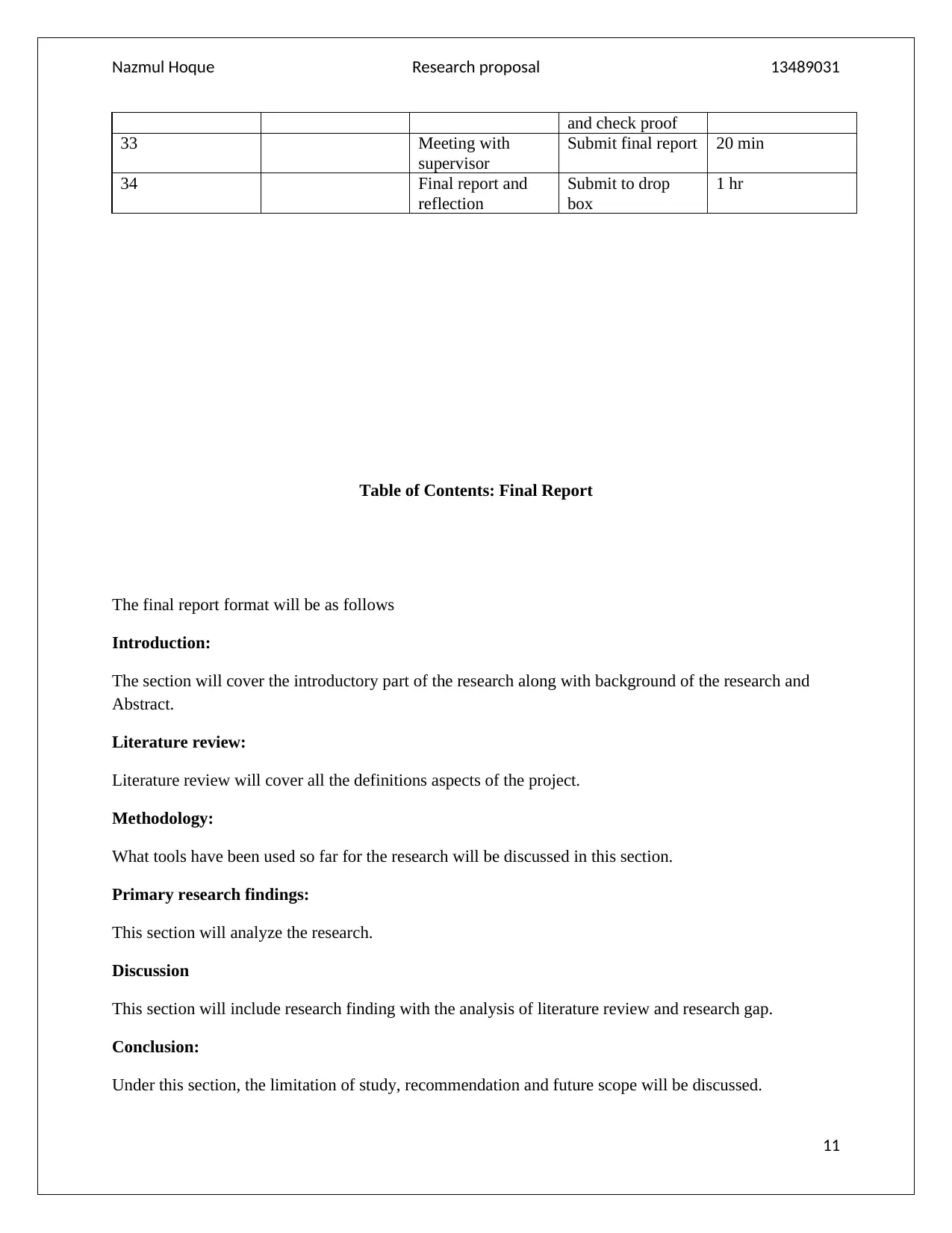
Nazmul Hoque Research proposal 13489031
and check proof
33 Meeting with
supervisor
Submit final report 20 min
34 Final report and
reflection
Submit to drop
box
1 hr
Table of Contents: Final Report
The final report format will be as follows
Introduction:
The section will cover the introductory part of the research along with background of the research and
Abstract.
Literature review:
Literature review will cover all the definitions aspects of the project.
Methodology:
What tools have been used so far for the research will be discussed in this section.
Primary research findings:
This section will analyze the research.
Discussion
This section will include research finding with the analysis of literature review and research gap.
Conclusion:
Under this section, the limitation of study, recommendation and future scope will be discussed.
11
and check proof
33 Meeting with
supervisor
Submit final report 20 min
34 Final report and
reflection
Submit to drop
box
1 hr
Table of Contents: Final Report
The final report format will be as follows
Introduction:
The section will cover the introductory part of the research along with background of the research and
Abstract.
Literature review:
Literature review will cover all the definitions aspects of the project.
Methodology:
What tools have been used so far for the research will be discussed in this section.
Primary research findings:
This section will analyze the research.
Discussion
This section will include research finding with the analysis of literature review and research gap.
Conclusion:
Under this section, the limitation of study, recommendation and future scope will be discussed.
11
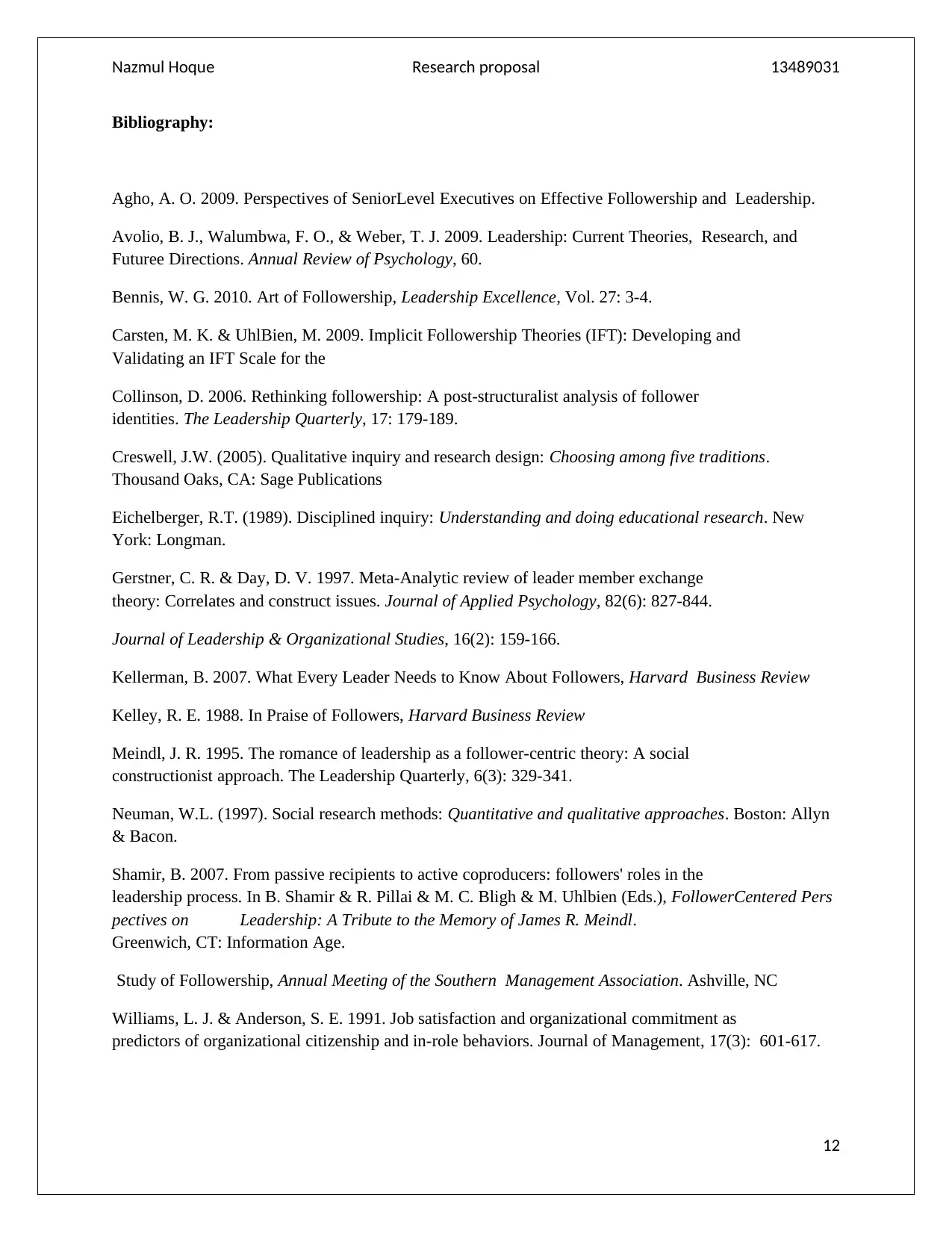
Nazmul Hoque Research proposal 13489031
Bibliography:
Agho, A. O. 2009. Perspectives of SeniorLevel Executives on Effective Followership and Leadership.
Avolio, B. J., Walumbwa, F. O., & Weber, T. J. 2009. Leadership: Current Theories, Research, and
Futuree Directions. Annual Review of Psychology, 60.
Bennis, W. G. 2010. Art of Followership, Leadership Excellence, Vol. 27: 3‐4.
Carsten, M. K. & UhlBien, M. 2009. Implicit Followership Theories (IFT): Developing and
Validating an IFT Scale for the
Collinson, D. 2006. Rethinking followership: A post‐structuralist analysis of follower
identities. The Leadership Quarterly, 17: 179‐189.
Creswell, J.W. (2005). Qualitative inquiry and research design: Choosing among five traditions.
Thousand Oaks, CA: Sage Publications
Eichelberger, R.T. (1989). Disciplined inquiry: Understanding and doing educational research. New
York: Longman.
Gerstner, C. R. & Day, D. V. 1997. Meta‐Analytic review of leader member exchange
theory: Correlates and construct issues. Journal of Applied Psychology, 82(6): 827‐844.
Journal of Leadership & Organizational Studies, 16(2): 159‐166.
Kellerman, B. 2007. What Every Leader Needs to Know About Followers, Harvard Business Review
Kelley, R. E. 1988. In Praise of Followers, Harvard Business Review
Meindl, J. R. 1995. The romance of leadership as a follower‐centric theory: A social
constructionist approach. The Leadership Quarterly, 6(3): 329‐341.
Neuman, W.L. (1997). Social research methods: Quantitative and qualitative approaches. Boston: Allyn
& Bacon.
Shamir, B. 2007. From passive recipients to active coproducers: followers' roles in the
leadership process. In B. Shamir & R. Pillai & M. C. Bligh & M. Uhlbien (Eds.), FollowerCentered Pers
pectives on Leadership: A Tribute to the Memory of James R. Meindl.
Greenwich, CT: Information Age.
Study of Followership, Annual Meeting of the Southern Management Association. Ashville, NC
Williams, L. J. & Anderson, S. E. 1991. Job satisfaction and organizational commitment as
predictors of organizational citizenship and in‐role behaviors. Journal of Management, 17(3): 601‐617.
12
Bibliography:
Agho, A. O. 2009. Perspectives of SeniorLevel Executives on Effective Followership and Leadership.
Avolio, B. J., Walumbwa, F. O., & Weber, T. J. 2009. Leadership: Current Theories, Research, and
Futuree Directions. Annual Review of Psychology, 60.
Bennis, W. G. 2010. Art of Followership, Leadership Excellence, Vol. 27: 3‐4.
Carsten, M. K. & UhlBien, M. 2009. Implicit Followership Theories (IFT): Developing and
Validating an IFT Scale for the
Collinson, D. 2006. Rethinking followership: A post‐structuralist analysis of follower
identities. The Leadership Quarterly, 17: 179‐189.
Creswell, J.W. (2005). Qualitative inquiry and research design: Choosing among five traditions.
Thousand Oaks, CA: Sage Publications
Eichelberger, R.T. (1989). Disciplined inquiry: Understanding and doing educational research. New
York: Longman.
Gerstner, C. R. & Day, D. V. 1997. Meta‐Analytic review of leader member exchange
theory: Correlates and construct issues. Journal of Applied Psychology, 82(6): 827‐844.
Journal of Leadership & Organizational Studies, 16(2): 159‐166.
Kellerman, B. 2007. What Every Leader Needs to Know About Followers, Harvard Business Review
Kelley, R. E. 1988. In Praise of Followers, Harvard Business Review
Meindl, J. R. 1995. The romance of leadership as a follower‐centric theory: A social
constructionist approach. The Leadership Quarterly, 6(3): 329‐341.
Neuman, W.L. (1997). Social research methods: Quantitative and qualitative approaches. Boston: Allyn
& Bacon.
Shamir, B. 2007. From passive recipients to active coproducers: followers' roles in the
leadership process. In B. Shamir & R. Pillai & M. C. Bligh & M. Uhlbien (Eds.), FollowerCentered Pers
pectives on Leadership: A Tribute to the Memory of James R. Meindl.
Greenwich, CT: Information Age.
Study of Followership, Annual Meeting of the Southern Management Association. Ashville, NC
Williams, L. J. & Anderson, S. E. 1991. Job satisfaction and organizational commitment as
predictors of organizational citizenship and in‐role behaviors. Journal of Management, 17(3): 601‐617.
12
⊘ This is a preview!⊘
Do you want full access?
Subscribe today to unlock all pages.

Trusted by 1+ million students worldwide
1 out of 12
Your All-in-One AI-Powered Toolkit for Academic Success.
+13062052269
info@desklib.com
Available 24*7 on WhatsApp / Email
![[object Object]](/_next/static/media/star-bottom.7253800d.svg)
Unlock your academic potential
Copyright © 2020–2025 A2Z Services. All Rights Reserved. Developed and managed by ZUCOL.